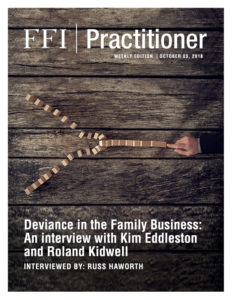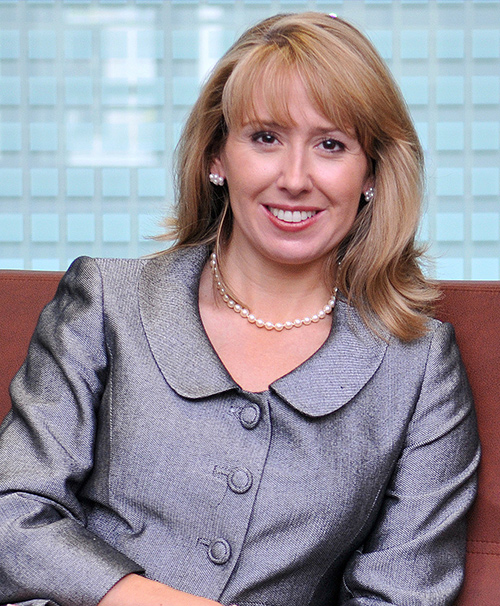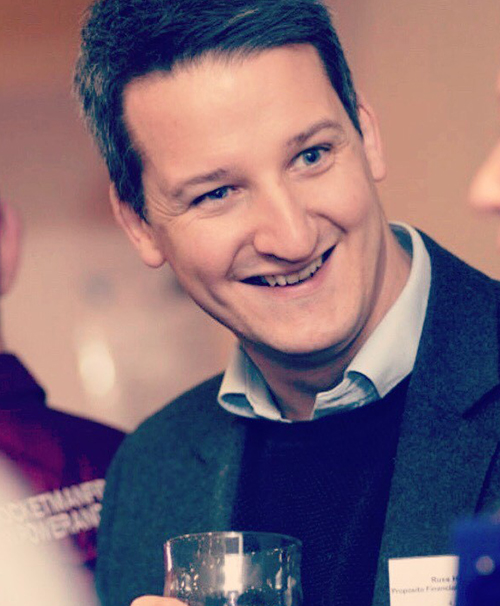
View this edition in our enhanced digital edition format with supporting visual insight and information.
For this week’s edition, we are excited to share an interview between Russ Haworth, host of the Family Business Podcast, and Kim Eddleston and Roland Kidwell about their presentation at the upcoming FFI Global Conference. Their presentation is titled “The Diversity of Deviance: How breaking the rules can hurt (and help) families and family firms,” which will address the different types and outcomes of deviance as well as covering how to use deviance in the family and family firm to improve performance.
Russell Haworth (RH): Hello and welcome to this week’s edition of FFI Practitioner, a publication brought to you by the Family Firm Institute. I’m Russ Haworth, and for this week’s edition I had the privilege of speaking with Roland Kidwell and Kim Eddleston who’ll be presenting at the upcoming FFI global conference in London from October the 24th to the 26. Their presentation is titled “The Diversity of Deviance: How breaking the rules can hurt (and help) families and family firms.” Professor Eddleston is widely published in the field of entrepreneurship. She has won multiple awards for her research on family businesses as well as women entrepreneurs and managers. Roland Kidwell is a distinguished professor of management and entrepreneurship whose teaching, research, and outreach efforts focus on entrepreneurship, family firms, franchising, and deviant or dysfunctional behavior in organizations. I enjoyed my chat with them, and I hope you do too.
Firstly, thank you Roland and Kim for joining us today. It’s a pleasure to have you on these series of podcasts from the FFI.
Roland Kidwell (RK): Good morning.
Kim Eddleston (KE): Good morning.
RH: So just to start us off, your research concerns the impact of deviant or dysfunctional behavior in family firms. What precisely do you mean by these terms and can you please explain how this deviant behavior can be both positive or negative within a family enterprise system?
RK: Sure. Deviance generally means violating norms or standards of behavior, and dysfunctional behavior is behavior that has adverse or negative consequences to the family firm. Here’s an example that we could use to illustrate the difference between negative and positive deviance. Let’s say we have a family member, the nephew of the boss — and in the firm, the norm is not to fire or dismiss family members. So, we have a situation where the nephew is an incompetent employee, and the boss fires the nephew. That would probably be a good example of a positive deviance. He (the boss) is deviating from the norm of not firing a family member, and it has positive consequences in that he’s getting rid of a poor performing family member.
On the other hand, let’s say the boss fires the nephew because the boss has a quarrel with the nephew’s parents. So again, he’s violating the norm by firing the family member, but the impact is perhaps dysfunctional to say that family member (the nephew) is performing incompetently. So that’s kind of the difference — where you have the same behavior and motivations, but it leads to positive or negative consequences depending upon the circumstance.
KE: That’s an excellent example. I think we can look at it another way too. If we think of deviant behavior or dysfunctional behavior, those are kind of easy terms to get your head around because almost everyone knows of a family firm that has a family member who only has a job because of their last name and they really, you know, bring problems to the business – treat it as their piggy bank.
Another way to look at positive deviance is simply as innovation and entrepreneurship. But a lot of families don’t want to change things in later generations because it’s their legacy or that’s how the founder always did it, or this is what we’re known for. And it takes someone with a lot of courage to come forward and say, you know, I want to change things. I want to be entrepreneurial and innovative. A lot of times entrepreneurs and innovators are going against the norm. They’re challenging the status quo. That would be another form of positive deviance, if you will.
RH: Great. So, what can families do to promote constructive deviance in the family enterprise whilst discouraging the destructive deviance?
RK: There are a lot of different kinds of approaches to that. One is culture — what are the shared values in the family firm? What is important, what do people act upon, what do people internalize as important values in the firm? If you can, attempt to institutionalize, as part of the culture, the things that Kim was talking about –innovation, new ways of looking at things.
The idea, too, of constructive confrontation. Basically, a situation where you don’t let behavior go by. You surface it, you talk about it. From there you develop values and approaches that may result in more positive behavior. Perhaps even breaking norms in a positive way, but also attempting to limit the amount of breaking of norms that have negative consequences.
The other potential way to look at this might be formalizing human resource management standards where you basically are putting together frameworks that apply to family members as well as non-family members in terms of how you hire people, how you promote people, how you engage in performance appraisals and compensation. But the idea is to focus on merit — trying to get away from the idea that you have a position because you’re a family member, but rather that you’re bringing something to the table, bringing talent to the table. Your performing well, and reinforcing that is particularly important.
RH: In your research you introduce a phenomenon you referred to as the “Fredo affect.” Can you provide some background about this phenomenon and explain how families can identify whether they have a Fredo in the family?
KE: So, this one’s very fun. Fredo comes from The Godfather, and Roland and I have used this term to bring some light to a very, very serious topic. I think that’s probably been one of the greatest highlights of doing this type of research and reaching out to families and doing workshops because it is a taboo topic. No one wants to admit that their son or their daughter is dysfunctional –that they take more than they give. So, I think by bringing this analogy from The Godfather and the Fredo affect, it brings some light to a very serious situation. It also allows families to talk about a very taboo topic Just to remind everyone, Fredo was the middle child of the Corleone family, and when he was stepped over, basically anything he did caused problems for the business. He betrayed the family. He caused more problems and eventually they get rid of Fredo.
RK: The idea behind it is basically that there is a family member who is an impediment to the success of the business. I mean that basically someone is standing in the way of the business meeting its goals. And what we were surprised about the first time we were doing some research was that 30 percent of the companies admitted that they had a Fredo. And you know, probably a lot more did. But we were surprised that so many admitted that there was this screw up in the business.
KE: Although have to say, when I present this at family business workshops, when I say that figure, a lot of people will say, “Oh, there’s even more. They just didn’t admit it.”
RH: What action should they take to protect the business from his or her negative impact?
KE: Probably the best thing to do is prevent the Fredo from ever entering the family business, which really means understanding your children’s strengths and weaknesses –why they’re drawn to the family business, whether they see it as something that they can actually contribute to or something that they’re going to more consume. Also, Roland mentioned the formalized HR practices – things like rules of entry; what are the minimal rules of entry family members need. Not creating a job just because of family member can’t find a job elsewhere or is constantly going from job to job. Doing things like formalizing appraisal process and promotions, creating a code of conduct and ethics, not showing favoritism to family members. Making sure that the family is treated the same as non-family and creating awareness of how the norms of the family conflict with the norms of the business.
When we think about the norms of the family versus those of the business, it’s really about allocation of resources. In a family, the norm of allocating resources is based on equality or even need. As a family we want to take care of the weak, and we usually want also to distribute resources equally. Well, that doesn’t work out very well in a business. In a business, resources should be allocated based on merit and equity. And a lot of times just making families aware of that and asking them how are they making this decision helps — are you’re wearing your dad hat or are you wearing your boss hat? I think that sometimes helps because then if the whole family is aware of the differences, they can then make smarter decisions and understand healthy business and healthy family and make sure the family is a resource to the business and not a constraint.
RK: One other thing that I don’t think you mentioned was the idea of fit. I mean, when you find someone who is an impediment, it could very well be that this family member has contributions to make, but they should not be in marketing – they should be in operations. They should be in an area that they are comfortable with. So, if you move people around and you’re open to that, that could be a way of dealing with the problem if it’s existing in the company. They just might not be in the right job.
KE: Something to add to that excellent point, Roland — and this is unique to family businesses again, with that fit — sometimes you’ll have family members, and, usually it’s because of a lack of communication, where it’s always been assumed that they are going to be in the family business, but they hate the job. They hate the industry. But, they don’t want to leave the family business because they don’t want their children to lose their opportunity to join the business or potentially be owners in the future. Just imagine, if you’re miserable in your job, you’re going to have a hard time performing to the standards of someone else. In a non-family business, if there was a lack of fit, you would leave. But unfortunately, in a family business a lot of times it’s because of family and expectations and obligations that people stay. Even though a lot of times when you talk about Fredo being a real deviant and dysfunctional, it’s more of a lack of fit or just a lack of competence for that industry or job.
RK: You know, they tried to send him to Las Vegas to work in the hotels and that didn’t work either, but they did try to find a fit for him. One thing that family business should not do is what they did to Fredo. However, at some point, you may need to take action. You may need to fire the family member and live with those consequences. It may get to that point. So that’s kind of the spectrum, I think of basically how to handle him.
RH: Brilliant. And what are the most notable implications that your research has on the field of family enterprise and what tips do you have for advisers when working with deviance in the family business?
KE: I think some of the most notable implications was that before we did this research, there was often a debate over whether the family was a resource or constraint, and they (the researchers) always looked at the family as a whole. Our research, instead, looked inside the family. And so even what looked like the most harmonious, the best family could still have this one person who was dysfunctional. And this deviance constrained the family relationships and the business. It created financial and emotional stress. And again, it’s not really a matter of if, but it’s a matter of when. So, I think that was probably one of the biggest contributions — saying let’s look inside a family and understand each person’s role. I think the tips for the advisers are a lot of what we had mentioned –prevention, understanding why people are there, if there’s fit and so forth.
But, I think another thing is this sense that you have to take care of and nurture your family — and there might be grandchildren. So, (for an adviser) to simply say, you’ve got to fire that person isn’t realistic. Sometimes if it’s going to hurt the entire child’s family and the grandchildren to give that advice, it’s not practical, and the family’s not going to listen to it. So probably what the adviser needs to do, even though that’s probably not the best answer, if you can, and they have skills, suggest that they can find another job. The other thing you need to do is understand the family’s obligations to take care of a child and their family and probably put the (dysfunctional) person in a position where they do the least amount of harm. I think that’s probably what advisers need to understand –finding that role where they can still be a part of the business, they still have a salary, they can take care of their own children and the grandchildren. But again, they’re going to do the least amount of harm to the business and the family.
RK: On the other side of this, looking at positive deviance, an adviser who develops some empathy with the family, discussing the family norms, the norms of the business, encouraging norms of fair dealing, norms of justice, empowerment, these kinds of things will help limit the negative deviance, but also encourage the positive deviance of innovation that you want to see to help the family firm move to the next generation. So, I think those are some ways to tie this back together where, if the ability’s there to work with the family to develop new norms, that work to limit the negative piece and encourage the positive deviance, that would be ideal — difficult, but ideal.
RH: Brilliant. Roland and Kim thank you very, very much indeed for your time. We’re really looking forward to seeing you in London at the FFI global conference. Until then, thank you very much.
RK & KE: Thank you very much.
About the contributors
 Kim Eddleston is Schulze Distinguished Professor of Entrepreneurship at Northeastern University and an academic scholar at Cornell University’s Smith Family Business Initiative. She has published more than 50 articles, and her award-winning research focuses on the interface of work and family. She actively participates in her own family’s business. Kim is the recipient of the 2018 Best Unpublished Research Paper Award and can be reached at k.eddleston@neu.edu.
Kim Eddleston is Schulze Distinguished Professor of Entrepreneurship at Northeastern University and an academic scholar at Cornell University’s Smith Family Business Initiative. She has published more than 50 articles, and her award-winning research focuses on the interface of work and family. She actively participates in her own family’s business. Kim is the recipient of the 2018 Best Unpublished Research Paper Award and can be reached at k.eddleston@neu.edu.
About Northeastern University
For more than 100 years, Northeastern University has been driven by a simple truth: Experience deepens learning like nothing else can. Through co-op, the schools’ pioneering, renowned experiential program, students put ideas into action in professional positions worldwide.
 Roland Kidwell, ACFBA, is a member of the FBR Review Board. He is professor of management, chair of the management department, and director of the Adams Center for Entrepreneurship at Florida Atlantic University. His research focuses on deviant behavior in family firms and elsewhere. He can be reached at kidwellr@fau.edu.
Roland Kidwell, ACFBA, is a member of the FBR Review Board. He is professor of management, chair of the management department, and director of the Adams Center for Entrepreneurship at Florida Atlantic University. His research focuses on deviant behavior in family firms and elsewhere. He can be reached at kidwellr@fau.edu.
About Florida Atlantic University Adams Center for Entrepreneurship
The Adams Center for Entrepreneurship brings students, faculty and the community together in the spirit of entrepreneurship to fuel the innovation needed to create new opportunities in the ever-changing global marketplace.
 Russell Haworth is a chartered financial planner with Proposito Financial Planning and a family business consultant based in the UK. He is the host of The Family Business Podcast, which is part of a wider educational and support initiative for family businesses from The International Centre for Families in Business. He can be reached at russell.haworth@proposito.co.uk.
Russell Haworth is a chartered financial planner with Proposito Financial Planning and a family business consultant based in the UK. He is the host of The Family Business Podcast, which is part of a wider educational and support initiative for family businesses from The International Centre for Families in Business. He can be reached at russell.haworth@proposito.co.uk.
About Proposito Financial Planning
Proposito Financial Planning specialize in working with family businesses to assist them with the transition of wealth and ownership between generations.

View this edition in our enhanced digital edition format with supporting visual insight and information.





